Nobody wakes up and says, “I want to be a micromanager.” The cycle of a toxic leader is slow and destructive to team performance.
You’ll learn how and why the micromanaging leadership cycle starts, how to identify how far in the cycle a team is, and actionable steps of reversing the toxic cycle (and how to prevent it from starting).
I’ve led thousands of teams and executives, and the micromanager is one of the most toxic leadership to team performance. It’s a slow cycle that creeps into the organizational culture and performance.
Micromanaging is costly in many ways. It can destroy a business if it is not identified and controlled. The Harvard Business Review wrote a great piece on the costs of disengagement caused by micromanagers. This statistic made my jaw drop:
…absenteeism caused by disengagement costs a typical 10,000-person company $600,000 a year in salary for days where no work was performed, and that “disengagement-driven turnover costs most sizable businesses millions every year.”
What is the core cause micromanaging and toxic leadership? Trust and control issues are almost always present. Many times the trust issues with micromanagers are with themselves and their lack of confidence in leadership.
Therefore, to accurately identify and ‘treat’ this toxic cycle of leadership, you must first understand the relation of trust as it relates to the primary function of a leader – influence. I’ll quickly walk you through this relationship.
Background – Trust as the Core of Influence
We have many resources on leadership and trust. I will recap some of the critical components of trust here as they relate to the cycle of toxic leadership.
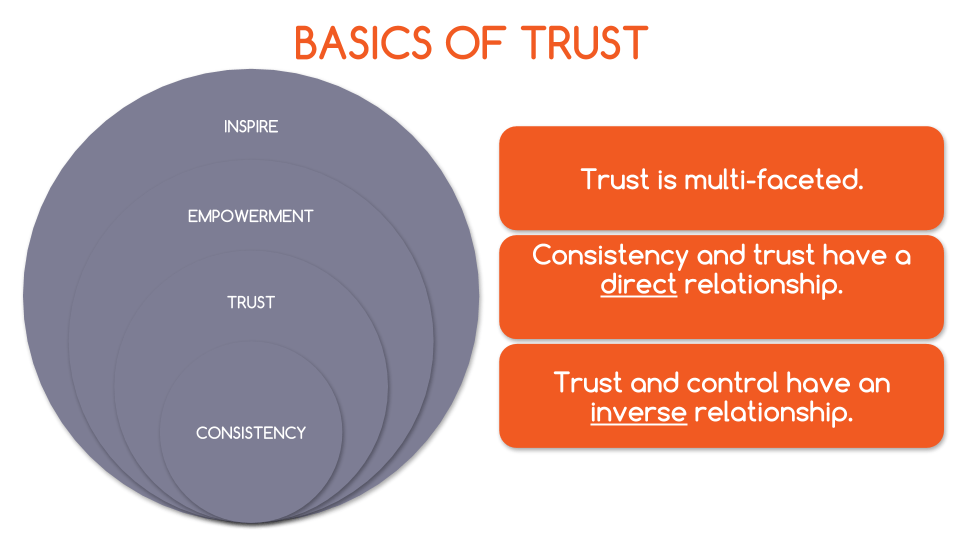
Trust is Dimensional
You can trust someone in one area but not another. Additionally, there are areas of your work and life that are easier for you to give trust.
Consistency & Trust Have a Direct Relationship
We build trust when we see in others what we deem as desired behaviors and attitudes. They think and act in the desired way, and that ‘way’ is always individually defined.
Even in our personal lives, we build trust with others when we experience a pattern of consistent and desired behaviors and attitudes in others. As soon as we stop seeing that consistency, trust diminishes.
If we never experience that consistency, we never build that trust. Once trust is built (or rebuilt), it grows to empowerment and eventually inspiration, with the latter being rare.
Trust & Control Have an Inverse Relationship
A lack of trust results in the desire to control or ‘micromanage.’ There is an inverse relationship between the need to control and trust.
An extreme lack of trust leads to fear, especially in leadership roles. My father was a USAF pilot for huge aircraft. He practically squeezed my hand off as a kid when we would be rolling down the runway for takeoff as passengers.
Why?
He needed to be in control – even when he wasn’t the leader.
The Birth of Toxic Leadership & Micromanaging: Meet Steve
I’ve seen the cycle countless times. When leaders lack trust, they will often work to control. This irrational need to control eventually leads to diminished team performance and lack of trust in the leader.
Let’s use the story of Steve, a call-center supervisor. Steve has a fantastic record as a leader and a great leadership following. Due to recent business change and transformation initiatives, Steve’s team performance suffered. Steve’s approach style was participative leadership until he met with his manager and was given a warning.
Steve – once a great leader – fell into a slow cycle of micromanaging and toxic leadership.
Here’s how it happened.
1. Micromanaging Begins with a Leader’s Lack of Trust in the Team
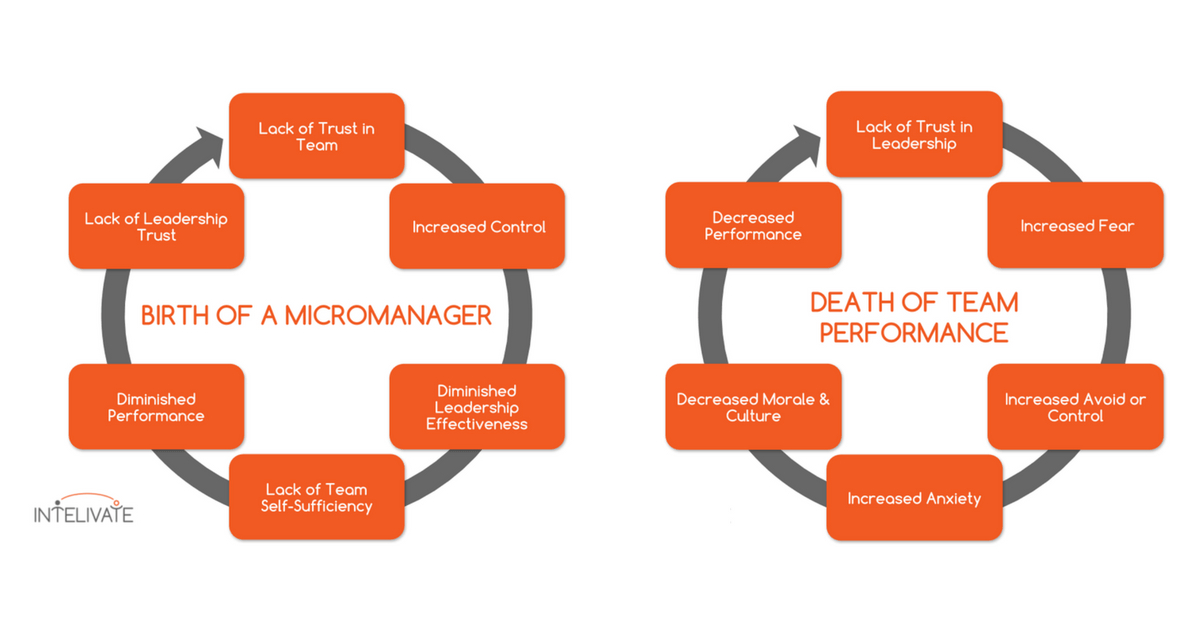
A stern warning about his team performance crushed Steve. He was the star leader. Steve developed a short-term plan to become more hands-on with his team. For this time, Steve felt a desire to take more functional control to quickly increase team performance.
Steve was quickly forgetting the difference between leadership and management.
2. The Micromanager Increases Control
What we don’t know we often fear. What we fear, we work to avoid or control. Suddenly, Steve felt he no longer knew how his team was doing work. Steve became more involved in each of his colleagues’ work, and he realized each of them could do it in a better way.
Because of the time-pressure to raise team performance, Steve found it easier to take some of the work himself. It was easier for him than explaining how it should be done. Although this soothed Steve’s concerns and slightly raised team performance in the short-term, you’ll soon realize how his micromanaging destroys any gains in the long-term.
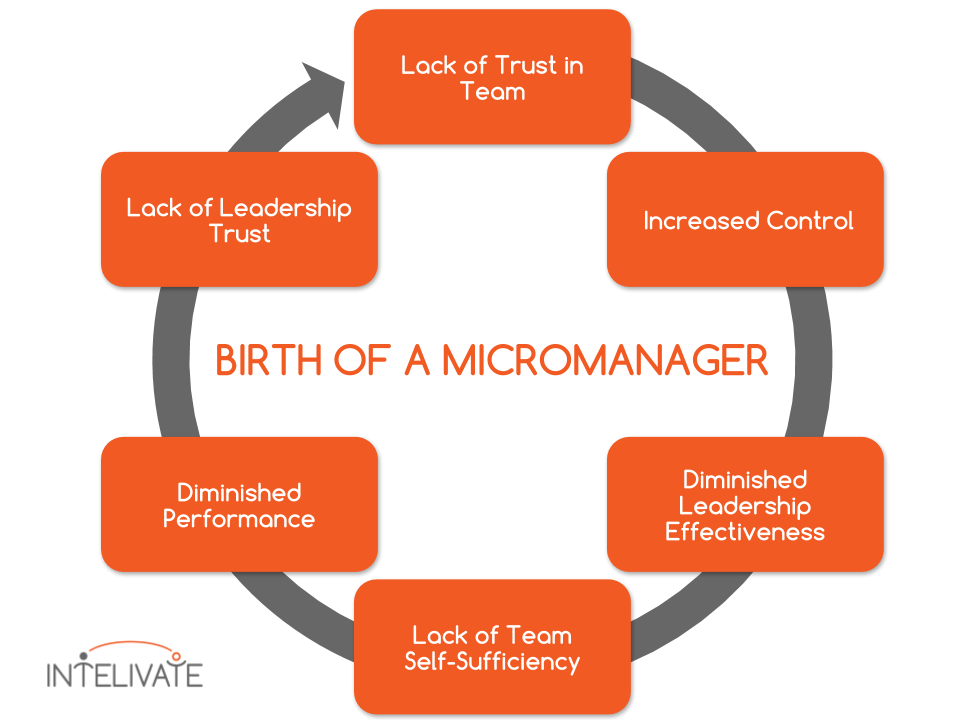
3. Micromanaging Diminishes Leadership Effectiveness
At first, Steve felt a sense of calm and accomplishment as team performance quickly improved. Although his tightly-controlled plan was designed for the short-term, he kept the approach. Instead of showing people how to do the work and helping them understand the reasons why Steve told them how to do their work.
In reality, Steve was taking much of the work for himself. He was no longer growing and teaching his team members for the long-run. Steve was micromanaging them for immediate team performance gains. Over time, his team members stopped learning and being self sufficient.
4. Micromanaging Causes Lack of Team Self-Sufficiency
One of the results of effective leadership is developing self-sufficient people and teams. The first result of toxic leadership is teams losing self-sufficiency.
Steve put into place a regimented twice-a-day inspection of each team member. He would review their work and then tell them exactly what to focus on and how to do the work until the next meeting. This worked in the short-term to raise team performance.
Steve’s team was normally self-sufficient so they used his feedback as a guide as opposed to a checklist. Some of them were reprimanded publicly by Steve to ‘just do what he tells them to do.’ Over time and as they encountered more communication barriers with Steve, his team stopped giving him as much feedback.
As this process continued, team members stopped seeking solutions themselves. They waited for Steve to tell them exactly what to do and how to do it. Steve’s control moved his team from self-sufficiency to being entirely dependent on Steve’s lists and direction.
What happened next absolutely perplexed Steve.
5. Continued Micromanaging Decreases Team Performance
Up to this point, Steve’s plan was successful. His team performance quickly improved. Eventually, the opposite began to happen – team performance diminished.
Steve couldn’t understand why this was happening. His plan was working up to this point. He was in a reactionary mode and couldn’t see past what was actually happening.
- His team was no longer self-sufficient. They waited and depended on him for everything.
- Steve was no longer teaching them which builds team growth. He was telling them. His team was no longer learning or evolving with any ongoing changes to the organization or business process.
- Steve’s daily capacity of his key resources – time, energy, talent, and patience – were over-allocated.
- As the business demands grew, he could no longer meet those demands.
The Death of Team Performance Begins
Once this point is reached in the cycle of toxic leadership and micromanaging, two critical things occur:
- The leader – Steve – begins to lose trust in himself as a leader. Trust in yourself is one of the vital team leadership characteristics.
- The team begins to lose trust in Steve’s leadership.
Unless both are identified and corrected, the micromanaging cycle of destruction continues. Each cycle amplifies the results of the previous cycle. As you can imagine, it becomes a dependent and vicious cycle.
6. Toxic Cycle Continues – Team Loses Trust in Leadership
Steve received pressure to increase team performance again. He was losing confidence in his own ability to lead. He strengthened his original plan and brought tighter control to his team. Steve once had confidence that his team would pull through for him. He was quickly losing trust in his team.
His team felt the pressure.
We do everything you say as our leader, yet we still aren’t successful.
Steve’s team lost faith in him as a leader. More destructive is they lost faith in themselves as a team. Both sides will have a difficult time rebuilding trust at this point.
7. Continued Cycle -Team Performance Symptoms of Toxic Leadership
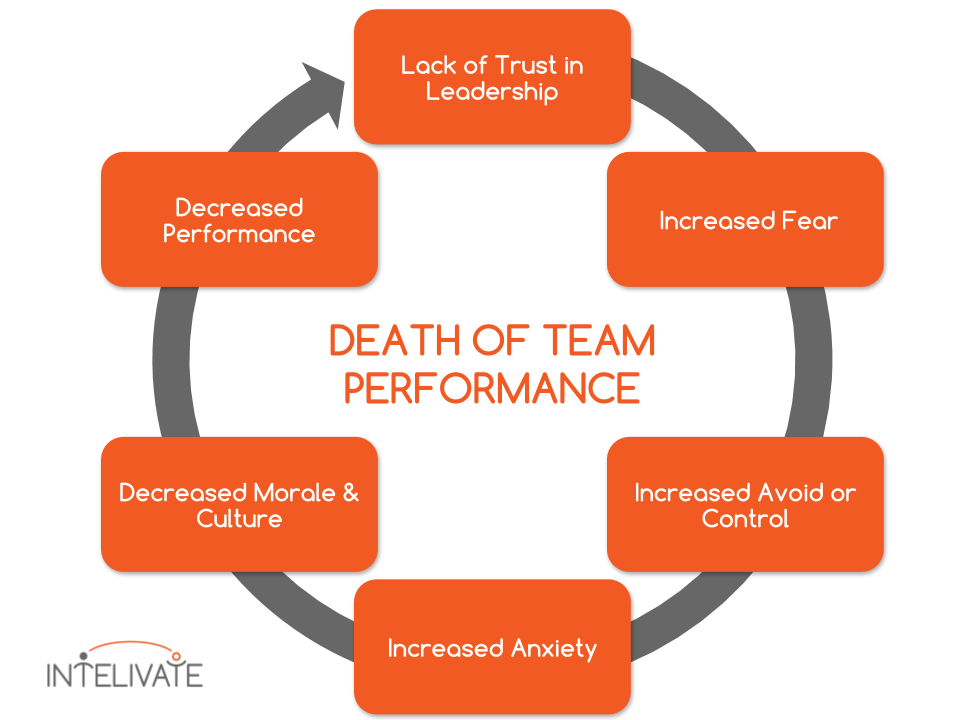
As team performance continued to diminish, people became fearful of their positions, careers, and future. We avoid or control those things we fear.
The team became more dependent on Steve and terrified of making mistakes. During this phase of the toxic leadership cycle, you’ll see more absences, more tardiness, more attrition, decreased engagement and employee satisfaction.
What do I see business do to correct the trends? They implement processes and programs that address the symptoms as opposed to the core issue – micromanagement.
Steve’s once great and proud team stood by watching other teams become more successful. The other teams were confident and trusting of their leaders so they were willing to take the risk needed to grow the business.
The morale and once positive culture that Steve’s team experienced plummeted. Decreased morale, combined with the other effects of micromanaging, further decreased team performance. Resentment built in both directions.
The Repeating Cycle of Toxic Leadership and Micromanaging
Steve never caught the cycle of his micromanaging to stop it, so it continued. With the last team performance dip, he trusted his team less and they trusted Steve less as their leader.
The next cycle was even more detrimental to both Steve and the team. Steve was demoted and moved to another department. Eventually, he left the organization.
Nobody helped him and he never helped himself.
Changing of the Leadership Guard – Choose Your Own Adventure

Sara is a superstar who was on Steve’s team and is replacing him as the leader. I see the Sara’s in these situations choose one of a few paths:
- Sara will replicate the toxic leadership cycle because that’s the only leadership style she has been exposed to during her career.
- Sara will take the 180-approach and immediately stop the tight control of micromanaging because she saw the destruction. However, the team is dependent on the control and an immediate withdrawal of it could add more harm.
- Sara will take a breath, take the time to evaluate the situation and then develop an individual approach to stop the cycle of micromanaging.
Sara decides on door #3, calls me to help her build an executive coaching and leadership development plan to put her new team on the right path to success.
Strategy for Stopping the Micromanaging Cycle & Team Performance Impacts
From a high-level, here is the plan that Sara and I developed. It’s the same plan I would give Steve to help him get out of the toxic leadership cycle.
1. Assess the team together.
Do a couple of round-table exercises and gauge team dynamics.
The goal of the first round-table session is getting the team open and comfortable to the leadership change. There are numerous ways to do this based on the situation. For Sara, it’s a fluid outline of to open up discussion.
The goal of the second round-table session is to identify team issues and where they think the priorities as a team should be to get back on track.
2. Assess each individual team member.
Sara has meetings with each team member. There are thousands of questions she could ask.
The main question is,
If you were in my role and situation, what would you do?
The answers Sara receives indicate the biggest fears that her colleagues have now. Sara looks for trends of both the team meetings and individual meetings and prioritizes those. She quickly shows small change by doing something with the feedback.
3. Build team confidence.
Sara’s team lacks confidence and morale.
The WORST thing she could do is to immediately relinquish all control – they now depend on that control. That’s like immediately ripping off the training wheels with absolutely no other support.
You’ll immediately fall and be less likely to try again. Based on individual assessments, Sara slowly builds confidence while providing more autonomy. They must be done together to repair the impacts of toxic leadership and micromanaging.
4. Meet with peers to discuss a plan, get feedback and incorporate into the plan.
Many leaders miss this one.
Sara must regain the confidence of her peers in her team. She’ll use this as a ‘PR’ move, gather valuable feedback, incorporate parts into her plan and demonstrate the use of the feedback. The last part promotes team success and builds confidence in her peers that Sara used their valuable feedback.
How to Prevent the Cycle of Toxic Leadership
It is easier and less costly to prevent micromanaging than to fix the cycle. Here are some quick points to keep in mind.
Check yourself and approach periodically to ensure you aren’t trying to control:
Controlling people through processes.
This starts the cycle of micromanaging and builds bureaucracy. Don’t standardize behavior, rather work to make behaviors consistent.
Assess areas that should be influenced.
In other words, focus on leadership, not control as it relates to your team members. As soon as you try and control every outcome of every team member, you become Steve – the toxic micromanager – and a bad leader.
Assess areas beyond your direct influence.
Keep your scope clear and don’t go too broad. You’ll stretch yourself too thin.
Tasks managed by others.
Let your team do their work. Guide and coach them, but don’t start doing the work for them. Remember – that’s how the cycle of micromanaging begins.
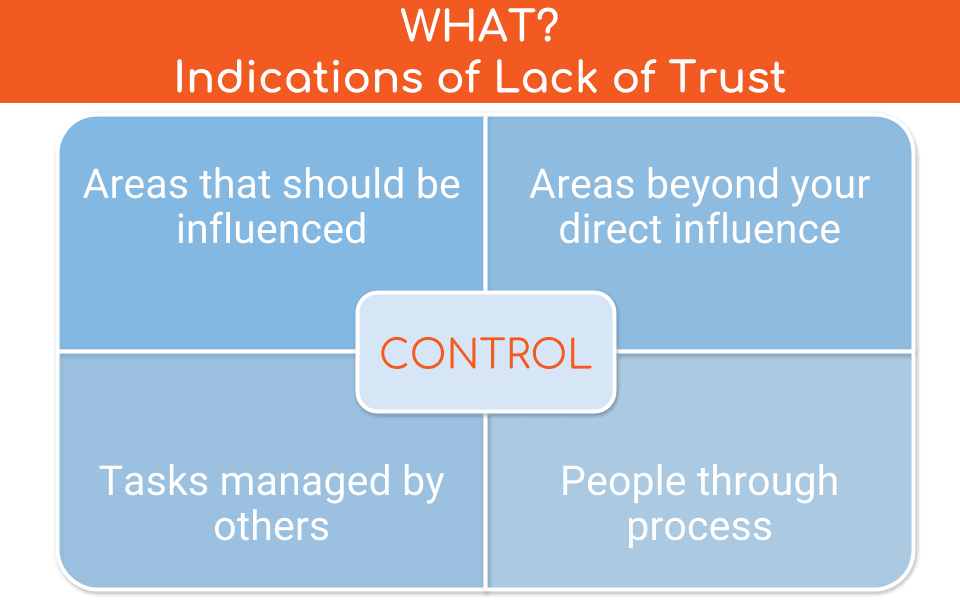
Build consistency to build trust.
Given the priorities of trust (fears) received from the team and individual meetings, periodically ask yourself these questions:
WHAT areas should I become more consistent?
WHY haven’t I been consistent in these areas?
HOW should I make those behaviors more consistent?
The WHY is especially important for sustainable change – and to avoid becoming another toxic, micromanaging Steve.
Are you dealing with a micromanager or getting into the cycle of toxic leadership? If you have any questions or want any additional pointers, I’d love to hear from you on Twitter or Facebook.
Was this article helpful? If so, subscribe to get our best advice and discussions delivered right to your inbox!
Keep Reading: Why You Need to Stop Using Incentives as Motivators and How to Use Each Effectively →
Related Solutions to Help You With Leadership and Team Performance.
Kris Fannin
Kris Fannin is a passionate change agent in workforce transformation. For more than 25 years, he's had the privilege of partnering with dozens of client organizations and leading hundreds of teams to become powerful influencers.
"Your legacy will be defined by the passion and impact of the people you influence. What do you want your legacy to be?"




